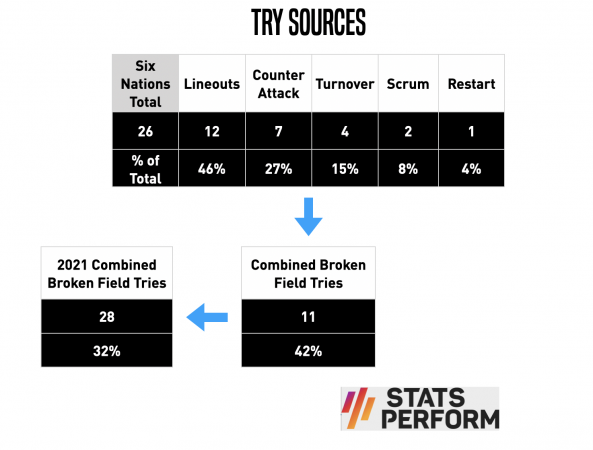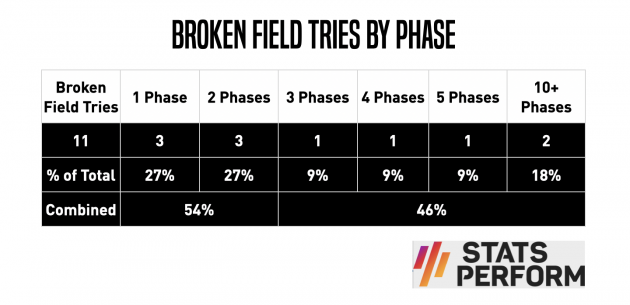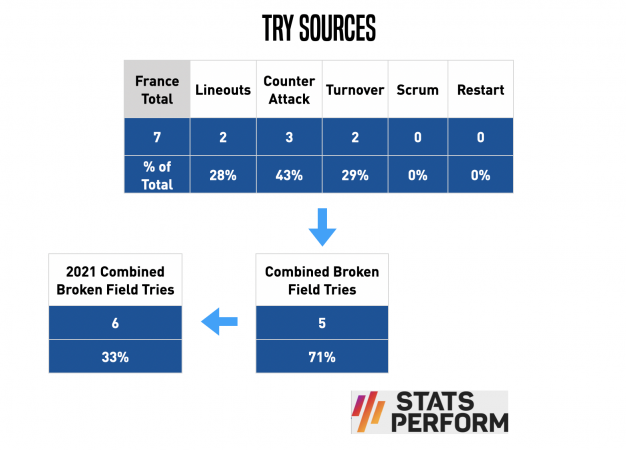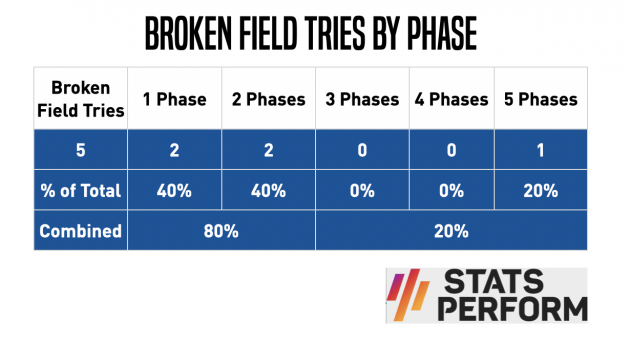In partnership with Opta by Stats Perform, Alan Dymock and Ross Hamilton take a look under the hood of some striking match data to bring you the story behind Six Nations stats. Next up: broken-field tries
Let’s start with a loose definition. If a score starts from a turnover, kick reception, counter-attack or a quick tap, it’s counted as coming from ‘broken field’. And in this Six Nations championship so far, according to data from Opta by Stats Perform, we are on track to beat last season’s number of scores in this vein.
Take a look at the breakdown of all try sources in this championship so far. It’s no surprise that for every rugby competition in the world, lineouts are most often the starting source. And so far this season, if you combined all of the scores from counter-attacks and turnovers (11), it’s still one fewer than from lineouts (12).

But if you look at this season after two games, compared to the whole tournament last year, there is already a 10% increase in the number of tries within the total coming from broken field. That’s 42% of all tries this year coming from broken field, while last year it was 32%.
There are already two interception tries within this – Anthony Jelonch’s score against Italy, and Taine Basham’s against Ireland.
However, this is also about taking your chances when they arrive in front of a disorganised opposition. As Nick Evans recently told us when we looked at the number of spills and rips in the Six Nations so far, when an opponent has to unexpectedly transition into defence: “You probably have a ten- to 20-second window where defences become out of system – position players out of system, backfield players out of system. It’s a big opportunity for us from the attacking side of the ball to create chaos to exploit, to create opportunities.”

Now look at how quickly the broken-field tries have been put away so far this year.
At the moment, 54% of them have been scored in one or two phases. That’s viper strike stuff, even with two intercepts in the mix.
Of course, as the phases rack up – and two tries that began from broken field took ten or more phases to convert into a score – you can question how broken things are. Defences clearly worked their way back into a groove. However, it still demonstrates how costly it is to hand the ball over to your rivals cheaply and then let them keep it.
Where things get interesting is again looking at France.

First, there is just the data. Last season France got six scores from broken-field starts. This season they already have five. A whopping 71% of their tries began from turnovers, kick receipts, counter-attacks or quick taps.
But there is also something else that deserves context. That number of five tries does not include Antoine Dupont’s try one minute into the Ireland match. Because it began with a lineout. That’s one of two scores France have had so far from that set-piece.
However, Dupont’s try began from a quick lineout – started by the man himself. You could say this was another ploy to attack against an unsettled defence.

There’s a sense that France are playing with a more ruthless intent. The rate of broken-field tries going up may at least hint at that without telling the whole story. Of course, it is also worth noting that Mathieu Jalibert started every France match in last season’s Six Nations, while Romain Ntamack is at the heart of things with Dupont this time round.
It is also worth a mention for Charles Ollivon, who is missing but in seasons gone by was seen as a real facilitator for broken-field brilliance. In his absence the French pack have still stepped it up this year.
Related: Six Nations Analysis: France’s Power Game
And with 80% of all of France’s broken-field tries being put away in one or two phases, that talks to the no-mucking-about energy of les Bleus at the moment.
At Murrayfield next week, they meet another side in Scotland who we all believe love to strike when the conditions break for them, and they can go through the gears when a chance is on. They had incredible red zone efficiency in round one, for example. But on current form, France are the masters of shattered fields. Neutrals will hope both sides can display the best of rugby amidst disarray.
Rugby World’s March 2022 edition is on sale from 1 February to 7 March 2022.
Download the digital edition of Rugby World straight to your tablet or subscribe to the print edition to get the magazine delivered to your door.
Follow Rugby World on Facebook, Instagram and Twitter.





